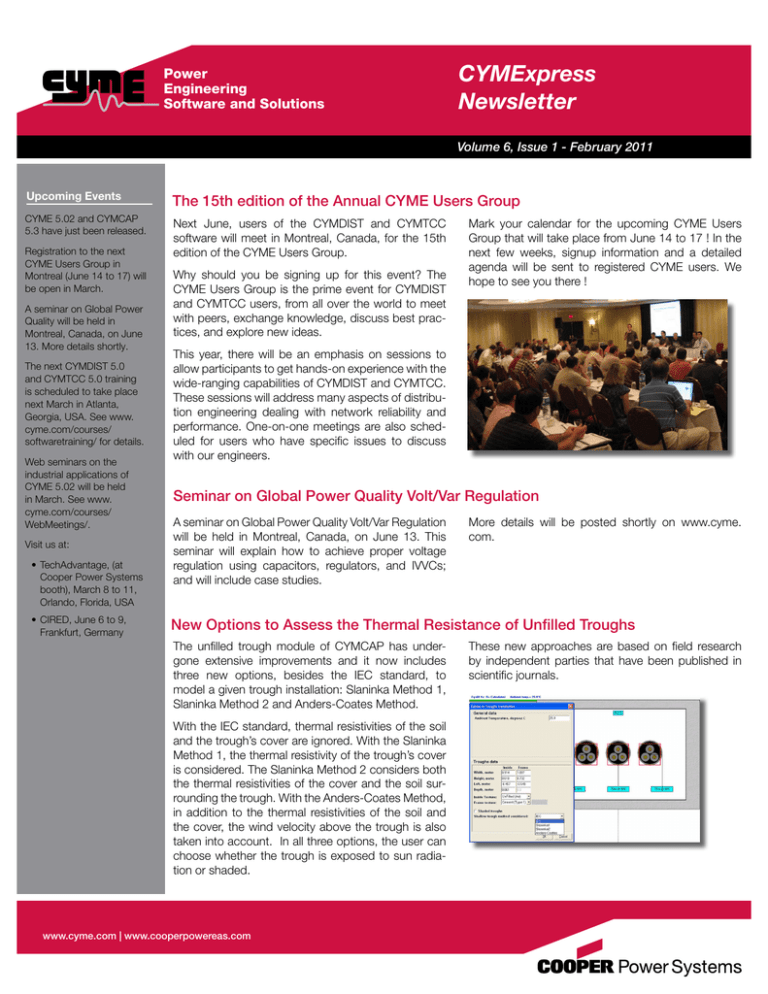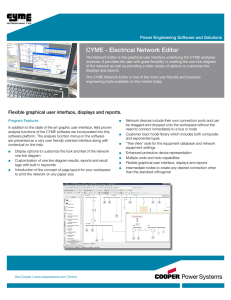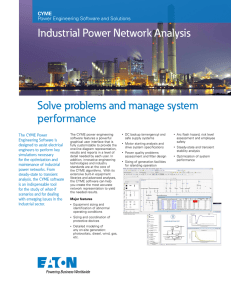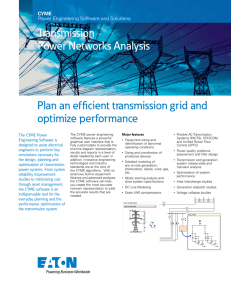
Power
Engineering
Software and Solutions
CYMExpress
Newsletter
Volume 6, Issue 1 - February 2011
Upcoming Events
The 15th edition of the Annual CYME Users Group
CYME 5.02 and CYMCAP
5.3 have just been released.
Next June, users of the CYMDIST and CYMTCC
software will meet in Montreal, Canada, for the 15th
edition of the CYME Users Group.
Registration to the next
CYME Users Group in
Montreal (June 14 to 17) will
be open in March.
A seminar on Global Power
Quality will be held in
Montreal, Canada, on June
13. More details shortly.
The next CYMDIST 5.0
and CYMTCC 5.0 training
is scheduled to take place
next March in Atlanta,
Georgia, USA. See www.
cyme.com/courses/
softwaretraining/ for details.
Web seminars on the
industrial applications of
CYME 5.02 will be held
in March. See www.
cyme.com/courses/
WebMeetings/.
Visit us at:
• TechAdvantage, (at
Cooper Power Systems
booth), March 8 to 11,
Orlando, Florida, USA
• CIRED, June 6 to 9,
Frankfurt, Germany
Why should you be signing up for this event? The
CYME Users Group is the prime event for CYMDIST
and CYMTCC users, from all over the world to meet
with peers, exchange knowledge, discuss best practices, and explore new ideas.
Mark your calendar for the upcoming CYME Users
Group that will take place from June 14 to 17 ! In the
next few weeks, signup information and a detailed
agenda will be sent to registered CYME users. We
hope to see you there !
This year, there will be an emphasis on sessions to
allow participants to get hands-on experience with the
wide-ranging capabilities of CYMDIST and CYMTCC.
These sessions will address many aspects of distribution engineering dealing with network reliability and
performance. One-on-one meetings are also scheduled for users who have specific issues to discuss
with our engineers.
Seminar on Global Power Quality Volt/Var Regulation
A seminar on Global Power Quality Volt/Var Regulation
will be held in Montreal, Canada, on June 13. This
seminar will explain how to achieve proper voltage
regulation using capacitors, regulators, and IVVCs;
and will include case studies.
More details will be posted shortly on www.cyme.
com.
New Options to Assess the Thermal Resistance of Unfilled Troughs
The unfilled trough module of CYMCAP has undergone extensive improvements and it now includes
three new options, besides the IEC standard, to
model a given trough installation: Slaninka Method 1,
Slaninka Method 2 and Anders-Coates Method.
With the IEC standard, thermal resistivities of the soil
and the trough’s cover are ignored. With the Slaninka
Method 1, the thermal resistivity of the trough’s cover
is considered. The Slaninka Method 2 considers both
the thermal resistivities of the cover and the soil surrounding the trough. With the Anders-Coates Method,
in addition to the thermal resistivities of the soil and
the cover, the wind velocity above the trough is also
taken into account. In all three options, the user can
choose whether the trough is exposed to sun radiation or shaded.
www.cyme.com | www.cooperpowereas.com
These new approaches are based on field research
by independent parties that have been published in
scientific journals.
CYMExpress
February 2011
The CYME Power Engineering Software for 2011
Released in December, the CYME 5.02 Power
Engineering Software brings new optional analysis
modules and enhanced tools that will greatly benefit
power engineers working on distribution or industrial networks.
This new version comes with new engineering analysis modules that work seamlessly together on one
single software platform. Enhancements include
multiple additions to the equipment models, and
extensions to the one-line diagram editing capabilities. All these features and more will be presented at
the CYME Users Group in June.
• The new brute force algorithm provides an
extension of analysis parameters and multiple
location optimization in the Load Balancing
module.
• Powerful features allowing the study of islanding
operation, generator fault contribution and
system response to transient events.
The new simulation modules include:
• The Embedded Protective Device Coordination
module which allows power engineers to
perform analyses requiring protection data, and
design their coordination scheme.
• The Load Flow Contingency module that
that allows creating contingency events and
scenarios. It operates in conjunction with the
power flow analysis modules of the program.
• The P-V Voltage Stability module assesses the
ability of a power system to maintain acceptable
voltage under any conditions.
CYME 5.02 also features several new tools to analyze the impact of faults:
• The Network Fault program is used to study,
in a batch mode, the global effect of faults
on different network locations. This program
is useful to determine fault contributions from
generators.
• The Voltage Sag program evaluates the impact
of the sudden reduction of voltage magnitude
following a fault on the system.
• The Fault Locator feature determines the
possible locations where a fault could have
occurred.
The following enhancements provide more precise
network modeling:
• Modeling of network protector equipment which
is primarily used in underground secondary
networks, grid systems, or spot networks.
• Modeling of instrumentation and controls used
on the network to improve reliability.
• Extension of the distributed generation
modeling capability, including PV cells as per
manufacturers’ data, and addition of a userdefined library of sun intensity models as a
function of time.
• Introduction of dynamic control models.
• Continuous enhancements to the CYME
equipment libraries.
• Capability to create device templates.
Other interesting enhancements to the simulation
applications include:
• The iterative search in the capacitor placement
simulation provides location options and their
potential impact on the network.
CYME International (part of Cooper Power Systems)
1485 Roberval, Suite 104
St-Bruno, QC Canada J3V 3P8
www.cyme.com | www.cooperpowereas.com
P: 450.461.3655
info@cyme.com
F: 450.461.0966
P: 800.361.3627 (Canada and USA)
© 2011 Cooper Industries, Inc. All rights reserved.








